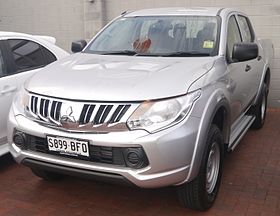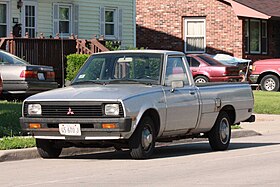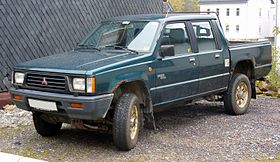
Mitsubishi L200

| Mitsubishi Triton | |
|---|---|
 |
|
| Overview | |
| Manufacturer | Mitsubishi Motors |
| Production | 1978–present |
| Body and chassis | |
| Class | Compact pickup truck |
| Layout | Front-engine, rear-wheel-drive or four-wheel-drive |
The Mitsubishi Triton is a compact pickup truck produced by Mitsubishi.
It was originally known as the Mitsubishi Forte in Japan from 1978 to 1986, when the name was discontinued as the pickup was not sold in its home market for a while It returned to Japan in 1991 as the Strada In the United States two captive imports of the Forte were sold by the Chrysler Corporation from 1979, as the Dodge Ram 50 and Plymouth Arrow Truck Mitsubishi itself imported it as the Mighty Max when it began selling directly in the US from 1982 to 1996, at which point the Plymouth ceased to be available In North America, after the Mighty Max was no longer offered, the Mitsubishi Raider was offered, sharing a platform with the Dodge Dakota In Japan, it was sold at a specific retail chain called Car Plaza
For most export markets the name L200 is used though it also been known as the Rodeo,Colt,Storm, Magnum, L200 Strakar (badge used in Portugal since 1999, Strakar is a portmanteau of Strada and Dakar), and others.
Cumulative sales of the first three generations exceeded 2.8 million units around the world.
Currently the pickup truck is sold in every available Mitsubishi market except the United States, Bulgaria, Canada, Japan, and China.
In late 2015, Fiat Professional has launched a rebadged model of the fifth-generation model, named the Fiat Fullback.
First generation (1978–1986)
| First generation | |
|---|---|
 |
|
| Overview | |
| Also called | Mitsubishi Forte Mitsubishi L200 Mitsubishi L200 Express (AU) Mitsubishi L200 Power X (TH) Mitsubishi Mighty Max (1982–1986) Chrysler D-50 (Australia) Chrysler L200 Express (Australia) Dodge D-50 (1979–1980) Dodge Ram 50 (1981–1986) Plymouth Arrow Truck (1979–1982) |
| Production | 1978–1986 |
| Model years | 1979–1986 |
| Assembly | Japan: Okazaki, Aichi (Nagoya Plant) |
| Body and chassis | |
| Body style | 2-door pickup |
| Powertrain | |
| Engine | 1.6 L 4G32/G32B I4 (gasoline) 2.0 L 4G52 I4 (gasoline) 2.0 L G63B I4 (gasoline) 2.6 L 4G54 I4 (gasoline) 2.3 L 4D55 I4-T (diesel) 2.5 L 4D56 I4 (diesel) |
| Transmission | 4-speed manual 5-speed KM132/KM145 manual |
| Dimensions | |
| Wheelbase | 2,780 mm (109.4 in) (SWB 2WD) 2,790 mm (110 in) (SWB 4WD) 2,950 mm (116 in) (LWB) |
| Length | 4,690 mm (184.6 in) |
| Width | 1,650 mm (65.0 in) |
| Height | 1,560–1,645 mm (61–65 in) |
The first generation model of Mitsubishi's compact pickup truck was first sold in Japan as the Mitsubishi Forte in 1978 and continued until late 1986, when the line was cancelled in the Japanese domestic market for five years. In Japan the Forte was originally sold with the 92 PS (68 kW) 1.6-liter 4G32 engine (L021P). Later this was updated to the 86 PS (63 kW) 1.6-liter G32B engine with two-wheel drive (LO25) or with four-wheel drive coupled to the 2.0-liter Sirius G63B with 110 PS (81 kW) (L026). Offered in basic Deluxe trim, the larger-engined version was also available in leisure-oriented Custom trim. The Custom also has a smoother and less utilitarian bed, without provisions for fitting a canvas top and with fewer hardpoints for strapping down loads.





In export versions, the 2.0-liter gasoline version has 93 hp (69 kW), while a larger 2.6-liter unit offered 105 hp (78 kW). Also popular in many markets, and frugal, was a 67 PS (49 kW) 2.3-liter diesel engine. The 73 PS (54 kW) 1.6-liter Saturn engine rounded out the lineup downwards in many countries. A naked cab and chassis version was also available in some markets.
Mechanical features included recirculating ball steering and front disc brakes, with rear-wheel drive suspension consisting front coil springs.Four-wheel drive (4WD) was added in 1981, featuring torsion bar suspension up front. The rear suspension for both comprised leaf springs with bias-mounted shock absorbers. The 4WD system incorporated an extra lever located alongside the main four-speed shifter. This provided three positions; 2WD in high-range, 4WD in high-range, and 4WD in low-range. In low-range, the vehicle travels at half road speed for any given engine rpm. The transfer case is chain-driven to the front wheels, making it stronger and quieter than the more common gear type. As such, the driver could shift between 2WD and 4WD in high-range without using the clutch, with the activation of low-range requiring the vehicle to be stopped. A warning lamp reminds the driver when 4WD is engaged.
The Dodge Ram 50 (called the Dodge D-50 for 1979 and 1980) was a badge-engineered version sold by the Chrysler Corporation from 1979 on. The label lasted until 1994, through two generations of the truck. Plymouth also received a version of the truck known as the Plymouth Arrow Truck, sold from 1979 to 1982. This was Chrysler's belated answer to the Ford Courier from Mazda and the Chevrolet LUV by Isuzu (both of which had been introduced in 1972). Mitsubishi itself imported it as the Mitsubishi Mighty Max when it began selling directly in the US from 1982, at which point the Plymouth ceased to be available. The Dodge version had quad rectangular headlights beginning with the 1983 facelift, while Mitsubishis and earlier Dodges had single units in North America. In the rest of the world, importers could choose between single or double rectangular units, as well as twin round headlights. The twin round units were the original fitment for the Japanese domestic market.
Four-wheel drive was added for 1982. This created the Power Ram 50 in the US, as in Dodge's nomenclature the "Power Ram" name was used for four wheel drive models. A turbo diesel engine was available in US models between 1983 and 1985. The 1983 turbodiesel was fitted with a TC05 non-wastegated turbo and produced 80 hp (60 kW) and 125 lb·ft (169 N·m) torque. The 1984–85 turbodiesels were fitted with a TD04 wastegated turbo which resulted in 86 hp (64 kW) and 134 lb·ft (182 N·m) torque.
Chrysler Australia launched the first generation in April/May 1979 as the MA series Chrysler D-50. Initially, two pickup versions were sold, the Commercial with the 1.6-liter Saturn (4G32) engine and the higher specification Recreational with the 2.0-liter Astron (4G52) engine. Commercials received the three-speed column-shift manual, with the floor-mounted four-speed transmission and taller axle ratio for the Recreational. Commercials were specified with heavy duty suspension rated for 1,000-kilogram (2,200 lb) payloads; the Recreational version carries a 500-kilogram (1,100 lb) load. The reason for the halved payload was due to the sedan-type suspension of softer springs and more supple shock absorbers. The Recreational model also featured radial ply tires, electronic ignition, bucket seats, pile carpet, radio, floor console, sports steering wheel and an adjustable steering column as standard. An optional sports stripe package was also available. Options included a weather-tight, fibreglass canopy with foam rubber mattress. This was manufactured by Challenge Industries and incorporated sliding side windows. Later in 1979, a cab chassis body variant of the Commercial was released. In March 1980, the D-50 was renamed Chrysler L200 Express to form linkage with the newly released L300 Express vans. In October 1980, the Chrysler labelling made way for Mitsubishi badges following the establishment of Mitsubishi Motors Australia from Chrysler Australia's old operations. In June 1981, Mitsubishi released 4WD versions of the pickup and cab chassis, both with the 2.0-liter motor. Free-wheeling hubs to reduce noise and fuel use in 2WD mode were optional. In late 1981, the 2.0-liter with five-speed manual was made optional for the 2WD one-tonne suspension models.
Second generation (1986–1996)
| Second generation | |
|---|---|
 |
|
| Overview | |
| Also called | Dodge Ram 50 (1987–1994) Mitsubishi Triton (Australia) Mitsubishi Cyclone (Thailand) Mitsubishi Colt (South Africa) Mitsubishi L200 Mitsubishi Mighty Max Mitsubishi Strada |
| Production | 1986–1996 |
| Assembly | Japan: Okazaki, Aichi (Nagoya plant) Brazil: Catalão |
| Body and chassis | |
| Body style | 2-door pickup 4-door pickup |
| Powertrain | |
| Engine |
|
| Transmission | 4-speed automatic 5-speed manual |
| Dimensions | |
| Wheelbase | Short Bed: 2,680 mm (105.5 in) Long Bed/Ext. Cab: 2,950 mm (116.1 in) |
| Length | Short Bed: 177.2 in (4,501 mm) Long Bed/Ext. Cab: 193.7 in (4,920 mm) Ext. Cab: 188.2 in (4,780 mm) |
| Width | 1,655 mm (65.2 in) Mighty Max 4WD: 65.9 in (1,674 mm) Mighty Max Sport Cab 4WD: 66.4 in (1,687 mm) |
| Height | Short Bed: 58.5 in (1,486 mm) Long Bed/Ext. Cab: 59.3 in (1,506 mm) 1991–93 Ext. Cab: 59.7 in (1,516 mm) 1987–1990 Ext. Cab: 59.6 in (1,514 mm) 1991–93 Long Bed/Ext. Cab 4WD: 64.4 in (1,636 mm) 1989–1990: 58.3 in (1,481 mm) |
| Curb weight | 1,220–1,635 kg (2,690–3,605 lb) |




The second generation model was introduced in 1986 for most markets. In Australia, this model launched in October 1986 as the low-cost Triton. In Japan the pickups were not sold for a few years, making their return as the Strada in Japan in March 1991. A facelift took place for the 1993 model year, with a new grille and new plastic bumpers comprising most of the changes. It continued to be produced until 1996. Sales in the Japanese domestic market continued into the middle of 1997. The truck usually has a 68 hp (51 kW) 2.5 litre diesel or a 84 PS (62 kW) turbo diesel engine, with the turbo diesel being the only engine available in the Japanese home market. The Triton was not a spirited performer, with a four-wheel drive V6 model having a top speed of 126 km/h (78.1 mph). The second generation Mitsubishi truck was also produced in Thailand. In the US it was known as the Mitsubishi Mighty Max or the Dodge Ram 50. Petrol engines include a carburetted 92 hp (69 kW) 2.0 litre inline-four or a 2.6-litre ditto with 109 hp (81 kW). Four-wheel drive (non-LSD) was also available, as were different bed lengths and both extended and double cab options.
Starting out as a fairly utilitarian truck, more comfortable versions were gradually added in most markets. In New Zealand & Australia, a small 3.0-litre V6 engine with 90 kW (122 PS; 121 hp) was added in early 1993. The V6 was not a well liked engine specification by consumers, as it did not tow as well or make as much torque as the diesel four-cylinder engine did, and used much more fuel than the four-cylinder.The 3.0L V6 6G72 equipped models also had a flaw in the design of the engine lifters- noisy lifters resulted in catastrophic engine failure over time. The locally developed L200 Sport range, more stylish and often featuring two-tone paintjobs, was very popular in New Zealand where the L200 was offered with five different engines.
Dodge Ram 50
The Ram 50 was redesigned for 1987, which was the same year Chrysler introduced the Ram 50's successor, the Dodge Dakota. Despite this, sales of the Ram 50 continued for another seven years until 1994, possibly because the Ram 50 was a compact and the Dakota was a mid-size. The difference in size and cost left a niche for the Dodge 50, and its cancellation may have been due more to a desire to show independence from Mitsubishi than because of any product overlap. The Mighty Max ended production after the 1996 model year, and its successor was not marketed in North America due to poor sales.
Third generation (1996–2006)
| Third generation | |
|---|---|
 |
|
| Overview | |
| Also called | Mitsubishi Colt (South Africa) Mitsubishi Triton (Australia) Mitsubishi L200 Mitsubishi Storm Mitsubishi Strada Mitsubishi Magnum Mitsubishi G-CAB |
| Production | 1996–2006 |
| Assembly | Thailand: Laem Chabang (Misubishi Thailand) Brazil: Catalão |
| Body and chassis | |
| Body style | 2-door pickup 4-door pickup 5-door wagon |
| Related | Mitsubishi Challenger |
| Powertrain | |
| Engine | 2.0 L 4G63 I4 (gasoline) 2.4 L 4G64 I4 (gasoline) 2.5 L 4D56 I4 (diesel) 2.5 L 4D56 I4-T (diesel) 2.8 L 4M40 I4 (diesel) 2.8 L 4M40 I4-T (diesel) 3.0 L 6G72 V6 (gasoline) |
| Transmission | 5-speed manual 4-speed automatic |
| Dimensions | |
| Wheelbase | 2,950 mm (116.1 in) |
| Length | 4,995 mm (196.7 in) |
| Width | 1,625 mm (64.0 in) |
| Height | 1,585–1,710 mm (62.4–67.3 in) |
| Curb weight | 1,295–1,700 kg (2,855–3,748 lb) |


In 1996, a new generation model was introduced with 2.5-liter turbodiesel engines developing 103 hp (77 kW). Other engine options include two sixteen-valve fuel injected gasoline engines and a naturally aspirated diesel. The previous 2.6-liter unit was replaced with a new, considerably more powerful 2.4-liter engine with 145 hp (108 kW). The car participated in the Dakar Rally in 2005. Production ended in 2006. These were only built in Laem Chabang, Thailand, and were also exported to Japan between 1997 and 1999. In late 2001 the third generation pickup underwent a facelift with new headlights and other changes.
An SUV model developed from the Mitsubishi Triton, called the Mitsubishi Challenger was released to Japan in 1996. In overseas markets it was also badged Montero Sport, Pajero Sport, Shogun Sport, or Nativa. Challenger shares many components and some body panels (i.e. front doors) with the Strada pickup truck and utilises the second generation Mitsubishi Pajero wheelbase. The Challenger was also produced in Thailand as the Mitsubishi Strada G-Wagon. The Thai model, unlike the same vehicle manufactured elsewhere used the same front styling as the Strada pickup truck that it was based upon. It was retired from production in 2005, but the nameplate was resurrected for the second generation of the Mitsubishi Challenger, launched in 2008 and which is also based on the following generation of the Mitsubishi Triton.
Fourth generation (2005–2015)
| Fourth generation | |
|---|---|

Mitsubishi L200
|
|
| Overview | |
| Also called | Mitsubishi L200 Mitsubishi Triton (Australia/Japan) Mitsubishi Strada (Philippines) Mitsubishi Sportero Mitsubishi Hunter (Israel) |
| Production | 2005–2015 |
| Assembly | Thailand: Laem Chabang (Mitsubishi Thailand) Brazil: Catalão (Mitsubishi Brazil) South Africa: East London (Daimler AG) |
| Body and chassis | |
| Body style | 2-door pickup 4-door pickup |
| Related | Mitsubishi Challenger |
| Powertrain | |
| Engine | 2.4 L 4G64 I4 (gasoline) 2.5 L 4D56 I4-T (diesel) 3.2 L 4M41 I4-T (diesel) 3.5 L 6G74 V6 (gasoline) |
| Transmission | 5-speed manual 4-speed automatic 5-speed automatic |
| Dimensions | |
| Wheelbase | 3,000 mm (118.1 in) |
| Length | 5,040 mm (198.4 in) FBB: 4,835 mm (190.4 in) Crew Cab: 5,115 mm (201.4 in) |
| Width | 1,750 mm (68.9 in) Crew Cab: 1,800 mm (70.9 in) |
| Height | 1,655 mm (65.2 in) Crew Cab: 1,775 mm (69.9 in) 4x4: 1,780 mm (70.1 in) |


The fourth generation Triton was unveiled in 2005. Designed by Akinori Nakanishi, it is built exclusively by Mitsubishi's subsidiary in Thailand and is exported to 140 global markets. It is mostly known as L200 except for Japan and its subsidiary countries' markets. The car has a 2.5-liter turbodiesel engine developing 134 kW (180 hp). The base version, available in some markets such as the Dominican Republic, has a 2.5-liter normally aspirated diesel engine and the L200 off-road version called the Savana punches out 176 hp.
There are many reports of this version having a curved, unlevel body wherein the left side is lower compared to the right side.
Fifth generation (2015–present)
| Fifth generation | |
|---|---|

Mitsubishi L200
|
|
| Overview | |
| Also called | Mitsubishi L200 Mitsubishi Triton (Australia and Israel) Fiat Fullback (Europe and Middle East) Ram 1200 (UAE) Mitsubishi Strada (Philippines) |
| Production | 2015–present |
| Assembly | Thailand: Laem Chabang (Mitsubishi Thailand) |
| Body and chassis | |
| Body style | 2-door pickup 4-door pickup |
| Related | Mitsubishi Challenger |
| Powertrain | |
| Engine | 2.4 L 4G64 I4 (gasoline) 2.4 L 4N15 I4-T (diesel) 2.5 L4D56 I4-T (diesel) |
| Transmission | 6-speed manual 5-speed manual 5-speed automatic |
| Dimensions | |
| Wheelbase | 3,000 mm (118.1 in) |
| Length | 5,210 mm (205.1 in) |
| Width | 1,820 mm (71.7 in) |
| Height | 1,780 mm (70.1 in) |


In 2014, Mitsubishi unveiled the all new L200 which is to go on sale in early 2015 (Asia Pacific) and late 2015 (Europe and the Caribbean). It's powered by a new 2.4-litre diesel engine. Since 2015, the current generation L200 will share the same underpinnings as the newly rebadged Fiat Fullback intended for the European and Middle East markets.FCA currently has no plans to introduce the Fullback in the North American market due to the U.S. chicken tax as well as plans by the Jeep brand to introduce a similarly-sized pickup truck based on the Wrangler SUV. For the 2017 model year, Ram Trucks rebadged the Triton as the Ram 1200 for the Middle East market.
